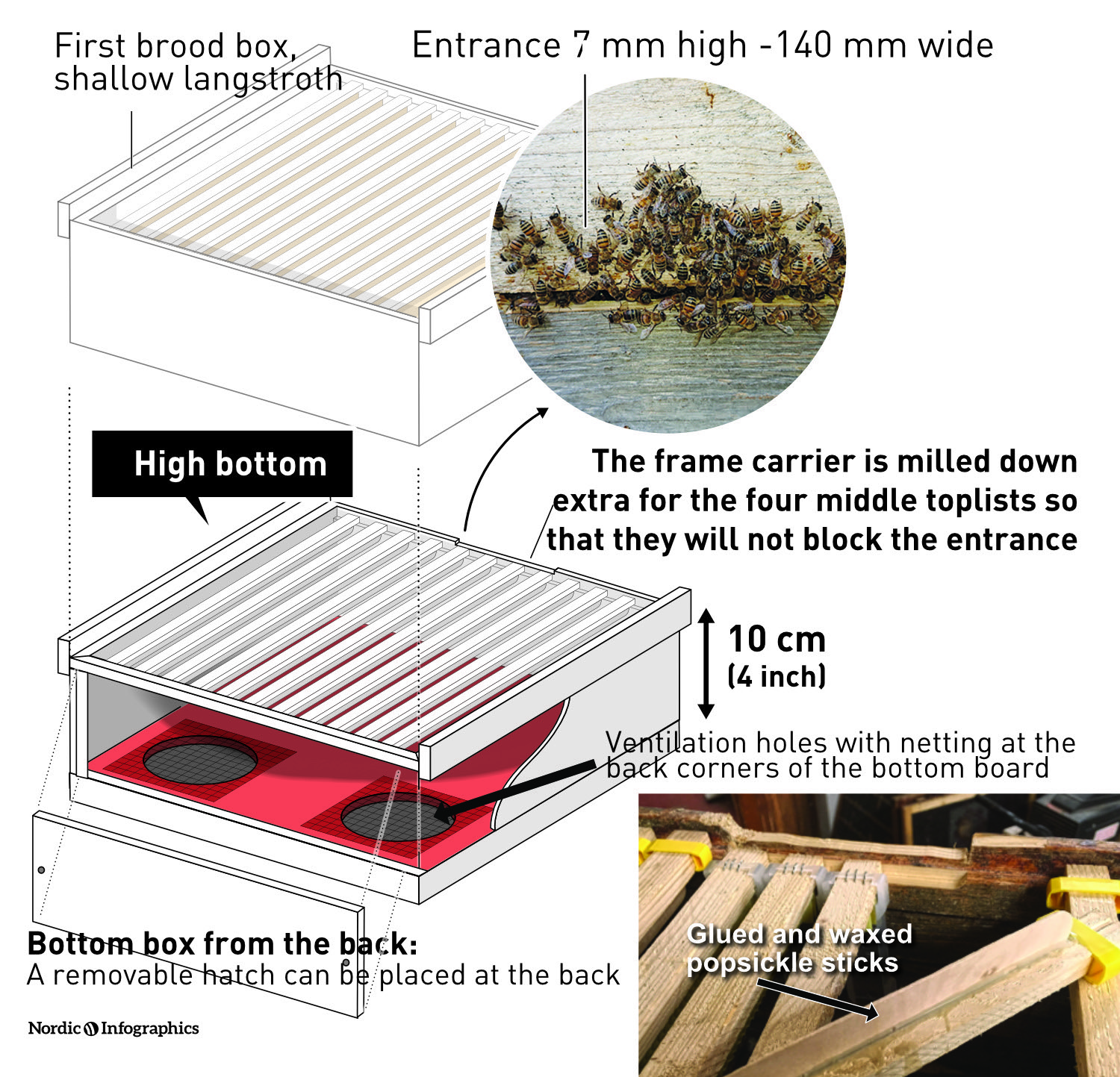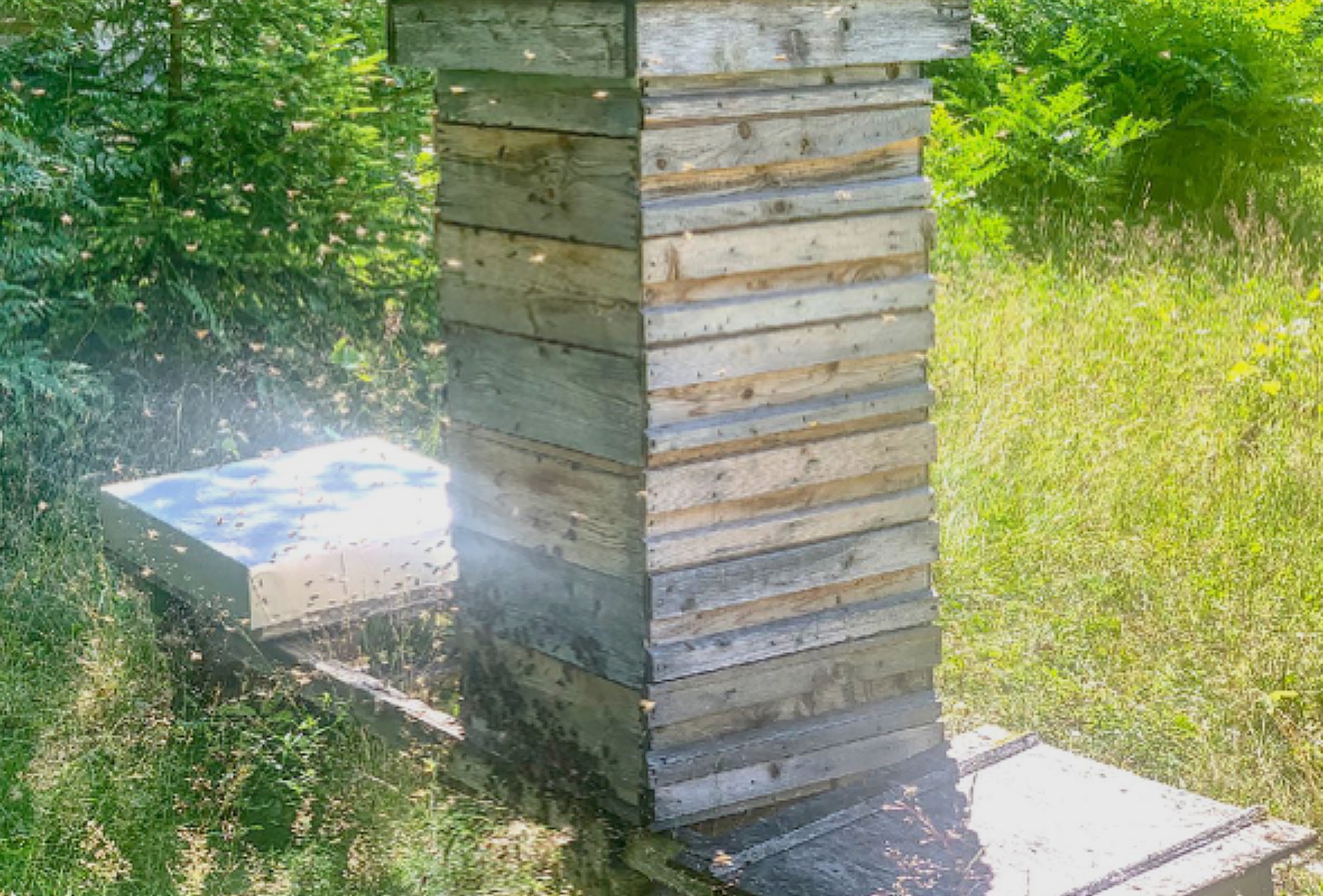Almost isolation
If you are lucky and have an apiary at least 2 km from other bees, your own or others, you can put one or two of your best colonies there to see if they can hunt mites and avoid reinvasion enough to become treatment free right away.
With a low mite population viruses will not grow much. If you are lucky the bees can stand the virus infection they develop with these few colonies in the apiary. Especially if your bees are not beginners on their path to a treatment free life.
Small entrances
Another way of helping bees against reinvasion problems is to keep entrances small, not bigger than 7 x 140 mm. Such entrances are easier to defend against intruders. It's not heavy robbing that is most often about to happen, but slow, so called silent robbing, which you hardly recognize.
Drifting is occuring more frequently when a mite population rises in a colony. Bees that fly out with a mite rider irritate the host so that it tries more than otherwise to enter the closest colony on their way back.
To hinder drifting, besides using small entrances, it's good to place colonies at a BIGGER DISTANCE from each other.
A high bottom helps
To be able to use such a small entrance as 7 x 140 mm it helps a lot to mimic the appearance of the bottom to how it's designed by a feral colony in for example a hollow tree. There you can often find an empty space below the combs. Also the entrance hole is often somewhat further up from the lowest part of the combs built by the bees.
To resemble this design you can make a shallow box even more shallow (about 10 cm, 4 inches, high) to be placed between ordinary boxes and a closed bottom. In upper front part of an "extra shallow" box you cut a notch, 7 mm deep and 140 mm wide. This will be the entrance when the first ordinary box is placed onto a bottom with such an extra shallow. This extra shallow will hold top lists with a 2-3 mm wide slot on its under side. In this slot you glue pop sickle sticks and wax them.
The bees can build small combs when they have nothing else to do. It seldom happens if you super the colony in time with its development. To help ventilation I use two 5 cm (2 inch) netted holes at the back corners in the tight bottom below the extra low shallow. Such a construction as this will put an end to clogging of the entrance of dead wet bees in wintertime. And gives the bees extra sheltered space if needed in summer.

Natural cellsize for the brood
When bees are adapted into drawing their own comb without the help of wax foundation they make different cell sizes for different purposes, smaller where they make brood and bigger where they store honey. In the brood area cell size varies as they do in the honey area. The average brood cell size is often 4.9 mm over the parallel sides, measured over at 10 cells. A good habit is to have at least a good part of the brood combs with 4.9 mm cells.
The existence of natural selection of the fittest point to a better fit bee, a bee with better survival characteristics if you let what occur naturally guide you. Anyway there's no way you will produce a bee less fit giving them a cell size that better corresponds to their own choice.
If you you have at least 4 combs of 4.9 mm cellsize in the middle of the broodnest you help your bees to better fitness, to survive and thrive.
Resistance traits
What are the traits that make bees resistance? They are more than one and more than just a few. We don't know how many they are.
When we say resistance we mean that the bees can on their own live a healthy life and thrive. Whenever we check the mite level in resistant colonies we will find a low level. If the level sometimes is higher, that is only temporarily and doesn't affect the bees much.
A HEALTHY MICROBIOME is important to keep the different populations of microbes under control, for example viruses.
There are other resistance traits against viruses, like FORCING OUT VISRUS-SICK BEES out of the colony and producing appropriate PEPTIDES (short proteins) that combine with viruses and annihilate them.
PROPOLIS is know to contribute to keep pathogenic microbes under control.
Good NOURISHMENT, like good pollen, as well.
The composition of LARVAL FOOD can affect the reproduction ability of the varroa mite. The bees can identify capped brood cell that contain mites, and UNCAP those BROOD CELLS. Some bees clean such cells, others recap them. Some bees can distinguish between capped brood cells that contain mites with offspring and those without offspring and only open those cells where mites have offspring.
Some bees GROOM themselves and other bees well from mites, and bite them.
Some bees DEFEND their ENTRANCE better from intruder bees (robber bees and drifting bees) than other. Thus avoid getting extra mites from those. Some bees are more INCLINED TO ROB other bees. Some DRIFT easier into wrong colonies. Thus they can spread mites.
All traits and different conditions, like number of colonies in an apiary, distance between the colonies and distance to other apiaries, will contribute to the resulting varroa level.
1. We set the varroa level as the first guideline for selection of inferior and superior bee colonies. We will thus get a summing-up of the breeding value that includes most types of traits, known and unknown.
We fine tune this summing up
2. with observations on a hard board in front of the entrance of eventual wing crippled bees,
3. development of the colony and
4.appearance of brood frames with capped brood.
These guidelines for developing varroa resistant bees works very well. For more on these guidelines see next article.
Resistance is growing
When the number of colonies that need treatment is definitely lower than 50% in an apiary you can consider increasing the number of colonies somewhat. It's good if you can increase the area with new apiaries now that are closer than 2 km from your best apiary. Or someone of the beekeepers you cooperate with may already have or will establish an apiary not so far away.
What you are doing now is building an area where good resistant bees are dominating. The number of them are more than 50%. The aim is to also develop the best part of this area to have only resistant bees.
What number of bee colonies can you have in a good resistant apiary? Try out by increasing the number one or two per year. Maybe you stop at 6 or 8 for some years.
I have a greater number than ideal in my home apiary, 18 colonies. 4 of these were treated 2020 (20%). But no one got full treatment (2 x 10 gram).
[Full treatment for colonies when you start with bees that havn't traveled long on the road to resistance is 2 x 10 gram + 2 x 10 gram (40 gram) or 2 x 5 gram + 2 x 10 gram (30 gram)]
2 of the four treated got half treatment 1 x 10 gram or 2 x 5 gram (10 gram)
2 got ¼ treatment 1 x 5 gram. One of the treated colonies got its treatment only in spring and then a new queen. The other three will get their queens replaced the coming season.
One colony died in late winter. Thus 5% winterloss in this apiary.
This apiary is doing a good job influencing the area with good drones.

This is breeder 104, used 2019. The photo was taken 2020. This colony was last treated for varroa in 2015. A daughter born 2019 will be used as a breeder in 2021. Almost all of the daughters of 104 gave a split in 2020. They were allowed to raise their own queen. These colonies will contribute with good drones.